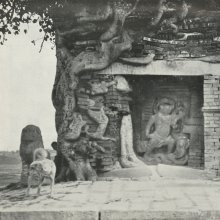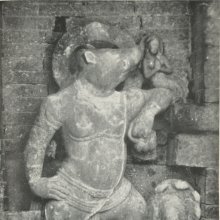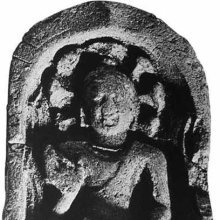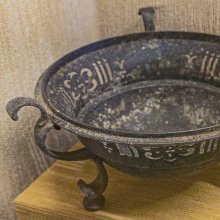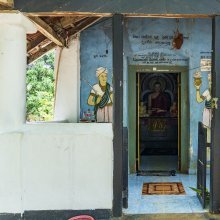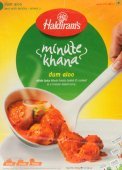Tum, Tūṃ, Tūm: 6 definitions
Introduction:
Tum means something in Hinduism, Sanskrit, the history of ancient India, Marathi, Hindi, biology, Tamil. If you want to know the exact meaning, history, etymology or English translation of this term then check out the descriptions on this page. Add your comment or reference to a book if you want to contribute to this summary article.
Images (photo gallery)
In Hinduism
Vyakarana (Sanskrit grammar)
Source: Wikisource: A dictionary of Sanskrit grammarTum (तुम्).—Krt affix तुम् (tum) of the infinitive (1) added to a root optionally with ण्वुल् (ṇvul) when the root refers to an action for the purpose of which another action is mentioned by the principal verb ; e.g. भोक्तुं व्रजति (bhoktuṃ vrajati) or भोजको व्रजति् (bhojako vrajati्); cf. Kas. on P.III.3.11; (2) added to a root connected with ' another root in the sense of desire provided both have the same subject; e.g. इच्छति भोक्तुम् (icchati bhoktum) ; cf. P. III. 3.158; (3) added to a root connected with the words काल, समय (kāla, samaya) or वेला (velā); e.g. कालो भोक्तुम् (kālo bhoktum) etc. cf. P.III.3.167; (4) added to any root which is connected with the roots शक्, धृष्, ज्ञा, ग्लै, घट्, रभ्, लभ्, क्रम्, सह्, अर्ह् (śak, dhṛṣ, jñā, glai, ghaṭ, rabh, labh, kram, sah, arh) and अस् (as) or its synonym, as also with अलम् (alam), or its synonym; e.g. शक्नोति भोक्तुम्, भवति भोक्तुम्, वेला भोक्तुम्, अलं भोक्तुम्, पर्याप्तः कर्तुम् (śaknoti bhoktum, bhavati bhoktum, velā bhoktum, alaṃ bhoktum, paryāptaḥ kartum) : cf. Kas. on P.III.4. 65, 66.

Vyakarana (व्याकरण, vyākaraṇa) refers to Sanskrit grammar and represents one of the six additional sciences (vedanga) to be studied along with the Vedas. Vyakarana concerns itself with the rules of Sanskrit grammar and linguistic analysis in order to establish the correct context of words and sentences.
India history and geography
Source: Shodhganga: Social folk customs of the Sonowal Kacharis and Thengal Kacharis of AssamTum refers to “A type of bamboo basket”.—It is included in the glossary section of the study on the Sonowal and Thengal Kacharis tribes of Assam (India) who possess a rich cultural heritage, folk customs, local traditions and oral histories

The history of India traces the identification of countries, villages, towns and other regions of India, as well as mythology, zoology, royal dynasties, rulers, tribes, local festivities and traditions and regional languages. Ancient India enjoyed religious freedom and encourages the path of Dharma, a concept common to Buddhism, Hinduism, and Jainism.
Biology (plants and animals)
Source: Google Books: CRC World Dictionary (Regional names)1) Tum in India is the name of a plant defined with Caryota urens in various botanical sources. This page contains potential references in Ayurveda, modern medicine, and other folk traditions or local practices It has the synonym Caryota urens Blanco (among others).
2) Tum in Thailand is also identified with Aegle marmelos It has the synonym Feronia pellucida Roth (etc.).
Example references for further research on medicinal uses or toxicity (see latin names for full list):
· Fragmenta Botanica. (1800)
· Flora de Filipinas (1837)
· Journal of Economic and Taxonomic Botany (2003)
· Taxon (1981)
· Species Plantarum
· Species Plantarum (1753)
If you are looking for specific details regarding Tum, for example health benefits, diet and recipes, pregnancy safety, extract dosage, chemical composition, side effects, have a look at these references.

This sections includes definitions from the five kingdoms of living things: Animals, Plants, Fungi, Protists and Monera. It will include both the official binomial nomenclature (scientific names usually in Latin) as well as regional spellings and variants.
Languages of India and abroad
Marathi-English dictionary
Source: DDSA: The Aryabhusan school dictionary, Marathi-Englishtūṃ (तूं).—pro Thou. tūṃ mī karaṇēṃ To thee and thou. Also tūṃ mīvara yēṇēṃ.
Marathi is an Indo-European language having over 70 million native speakers people in (predominantly) Maharashtra India. Marathi, like many other Indo-Aryan languages, evolved from early forms of Prakrit, which itself is a subset of Sanskrit, one of the most ancient languages of the world.
Hindi dictionary
Source: DDSA: A practical Hindi-English dictionaryTum in Hindi refers in English to:—(pro) you..—tum (तुम) is alternatively transliterated as Tuma.
...
Tamil dictionary
Source: DDSA: University of Madras: Tamil LexiconTum (தும்) particle Verbal ending of the 1st person plural, denoting past or future tense, as in செய்தும்; இறப்பெதிர்காலங்களைக் காட்டும் தன் மைப்பன்மை வினைமுற்று விகுதி. [seythum; irappethirkalangalaig kattum than maippanmai vinaimurru viguthi.] (நன். [nan.] 332.)
--- OR ---
Tum (தும்) noun < Telugu dummu. Dust; தூசி. தும்பறக்க அடித்தான். [thusi. thumbarakka adithan.] (W.)
--- OR ---
Tūm (தூம்) noun [Telugu: tūmu.]
1. A dry measure of capacity; முகத்தலளவைவகை. குப்பத்தூம், தேவதூம். [mugathalalavaivagai. kuppathum, thevathum.] (W.)
2. Bazaar weight = about 6 lbs. 4 oz. avoir.; ஒரு நிறை. [oru nirai.] Local usage
Tamil is an ancient language of India from the Dravidian family spoken by roughly 250 million people mainly in southern India and Sri Lanka.
Nepali dictionary
Source: unoes: Nepali-English DictionaryDhum is another spelling for धुम [dhuma].—n. clamor; revel; uproar;
Nepali is the primary language of the Nepalese people counting almost 20 million native speakers. The country of Nepal is situated in the Himalaya mountain range to the north of India.
See also (Relevant definitions)
Starts with (+26): Tuma, Tumaca, Tumada, Tumadara, Tumaka, Tumakhlung, Tumaki, Tumala, Tuman, Tumana, Tumani, Tumar, Tumara, Tumari, Tumaru, Tumatama, Tumatumita, Tumb, Tumba, Tumbabana.
Query error!
Full-text (+269): Thum, Kantatun-katiyatum, Dum, Cah dum, Ka-thum' theet, Che'k tum phka loeng, Phut tum, Tum-thang, Nakapher-tum, Tum kaa daeng, Tum kaa khao, Uddhumayati, Dum molucca, Ma tum, Tum-ka-daeng, Dum-kaag, Dum kalleti, Dum las huwowfng, Tum-dak, Thum riat.
Relevant text
Search found 69 books and stories containing Tum, Dhum, Dum, Thoom, Thum, Tūṃ, Tūm; (plurals include: Tums, Dhums, Dums, Thooms, Thums, Tūṃs, Tūms). You can also click to the full overview containing English textual excerpts. Below are direct links for the most relevant articles:
World Journal of Pharmaceutical Research
Simultaneous UV-visible estimation of caffeine and benzoic acid. < [2017: Volume 6, May issue 5]
Standardization of modified dhum netra < [2018: Volume 7, April issue 7]
To study pratimarshya nasya and its health benefits – a review < [2017: Volume 6, April issue 4]
Preksha meditation: History and Methods (by Samani Pratibha Pragya)
Appendix 1 - Mūlapāṭha of Jayācārya’s Texts, etc.
Bibliography II: Terāpantha-Literature including Mahāprajña’s Literature on Prekṣā-Dhyāna
Shatahvadi Basti and Dhum Nasya in Labor Augmentation: A Case Study < [Volume 10, Suppl 3: May-June 2023]
Nasya with shadbindu taila for migraine: laxmibilas rasa, pathyakshadhatrayadi. < [Volume 1, issue 1: September - October 2014]
To study the nidanpanchak of doshaj kasa < [Volume 5, Issue 6: November-December 2018]
International Ayurvedic Medical Journal
Role of dhumpana in nasal pathologies < [2020, Issue 1, January]
Role of samshodhan chikitsa in jeerna pratishyay < [2016, Issue II February]
“management of internal haemorrhoids with apamarga partisarniye kshara”: a case study < [2022, Issue 07 July]
Rig Veda (translation and commentary) (by H. H. Wilson)
Rig Veda 10.61.17 < [Sukta 61]
Guhyagarbha Tantra (with Commentary) (by Gyurme Dorje)
Text 15.35 (Commentary) < [Chapter 15 (Text and Commentary)]
Related products
